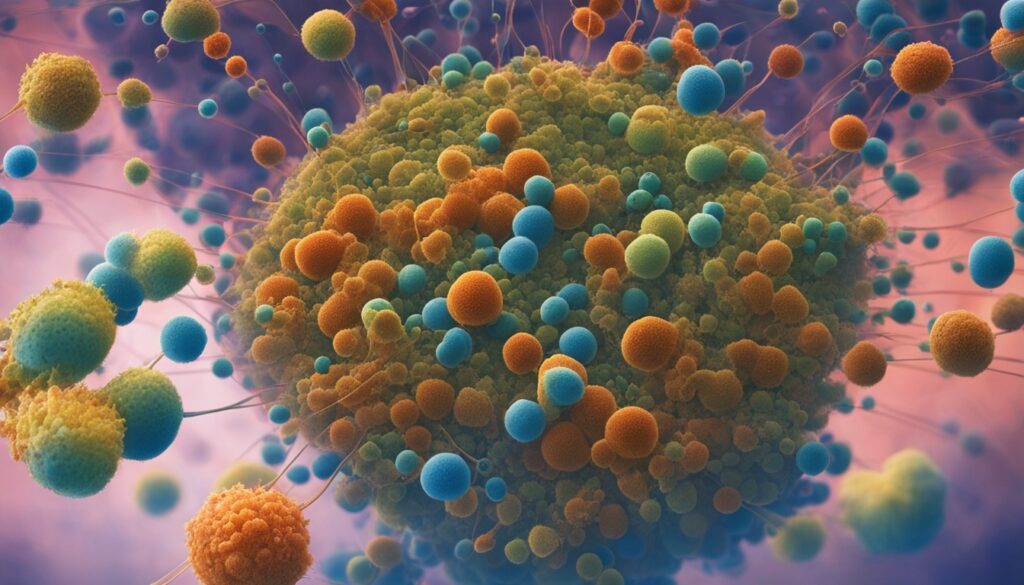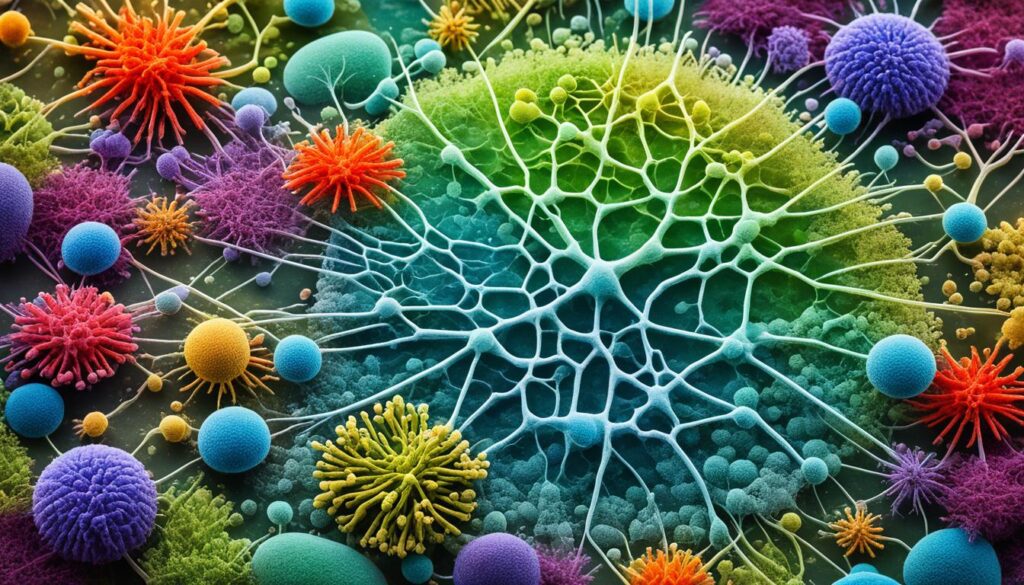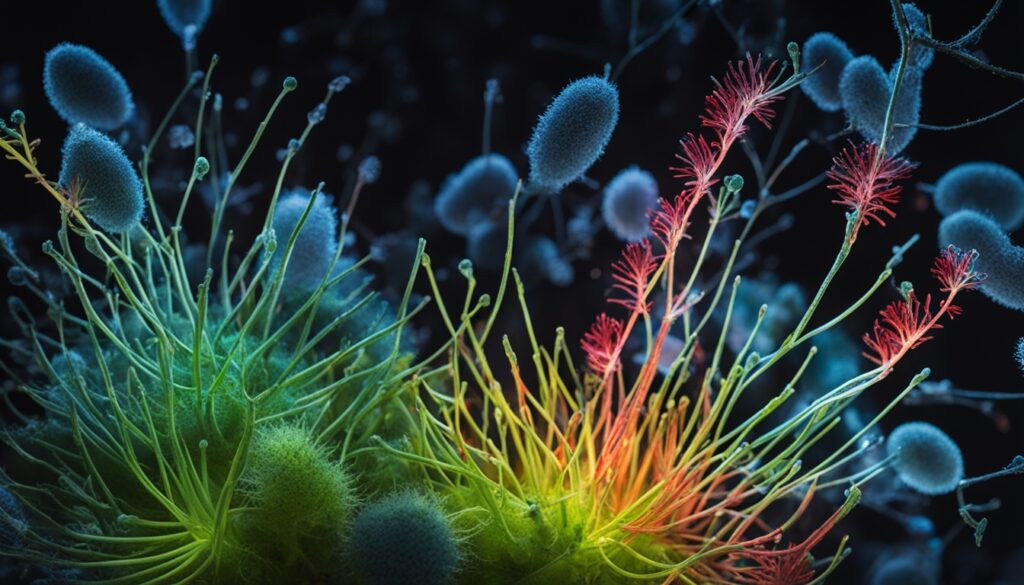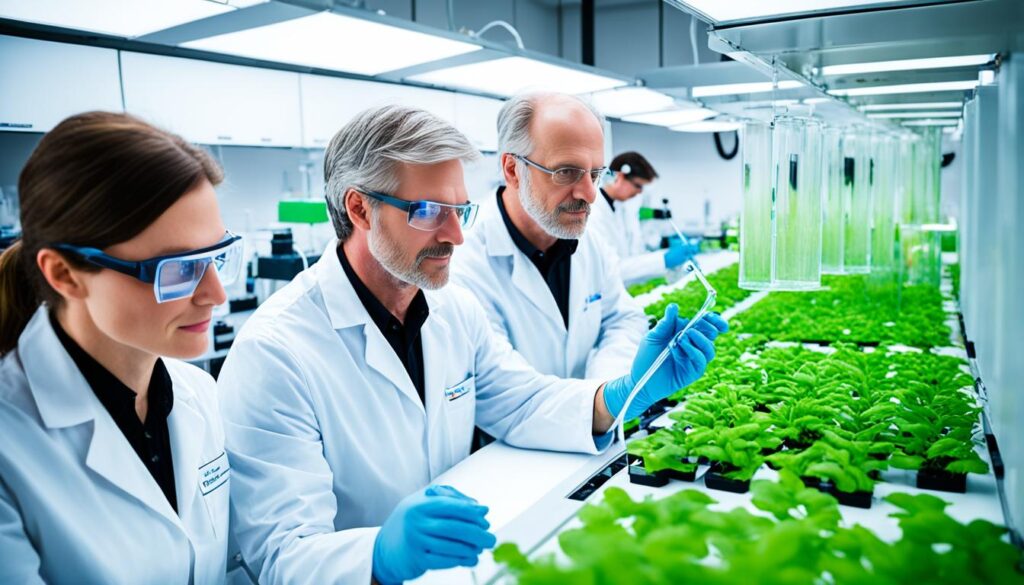Did you know our bodies can sense bacteria talking? This cool fact is thanks to the aryl hydrocarbon receptor inside us. It alerts our immune system when lots of bacteria gather. This helps get our defenses ready.
The silent chats among bacteria are mind-blowing. They talk about everything from how to survive to making us sick with things like pneumonia.
In the world of tiny creatures, bacteria have complex talks using bacterial communication. They send out chemicals called quorum sensing molecules. These tell them when to attack or defend against things like antibiotics. Exploring microbial life shows us how these tiny signals are really powerful in the bacterial world.
Learning about quorum sensing shows us how smart bacteria are. They can change to fit their surroundings and even affect our health in big ways.
Key Takeaways
- Bacteria use quorum sensing molecules to communicate and coordinate actions.
- The aryl hydrocarbon receptor helps our immune system detect bacterial communication.
- Quorum sensing is crucial for determining when bacteria should produce illness-inducing substances.
- High population density in bacteria enhances their immune response up to 500-fold.
- Overactivity of the CRISPR/Cas system in bacteria can lead to their death.
- Understanding quorum sensing can inform strategies to combat bacterial infections.
Understanding the Basics of Bacterial Communication
Bacterial communication is quite amazing. These tiny organisms are 500 times smaller than human cells. They coordinate their activities through complex systems. They use chemical signals to talk to each other in different places. This helps us understand how they work together and survive.
How Bacteria Utilize Chemical Signals
Chemical signals are crucial for bacteria to talk to each other. These signals are called autoinducers. They help bacteria know how many of them are in a place and act together. Thanks to quorum sensing, bacteria can do things they can’t do alone. They can “speak” many chemical “languages”, allowing them to interact with many types of bacteria.
The Importance of Intercellular Communication
Bacteria talking to each other is key for working well together. For example, they can form biofilms on surfaces by sticking together. This helps them get food and stay safe from dangers. It’s also how they form harmful groups that can make us sick. Controlling toxins through quorum sensing is a big deal for these groups to harm during infections.
Studies have looked into how moving water affects bacterial talks. Fluids can carry away their chemical messages, challenging biofilm communication.
Understanding this can help us fight bad bacterial activities in hospitals and the environment.
| Aspect | Details |
|---|---|
| Bacterial Size | 500 times smaller than a human cell |
| Purpose of Communication | Share information, coordinate activities, and accomplish tasks collectively |
| Mechanism | Utilizes chemical signals known as autoinducers |
| Community Formation | Biofilms and toxin production controlled by quorum sensing |
| Influence of Fluid Flow | Affects delivery of chemical signals and bacterial cooperation |
What is Quorum Sensing?
Quorum sensing lets bacteria communicate and adapt to where they are. They use chemical signals to know how many of them are there and change their behavior.
Defining Quorum Sensing
Quorum sensing lets bacteria sense their numbers and work together. They can do things like make toxins, glow, or form biofilms. This teamwork helps them survive as a group, not just alone.
Key Components: Autoinducers and Their Role
Autoinducers are chemicals that bacteria use to talk to each other. Different bacteria make different autoinducers for different actions. For example, Staphylococcus aureus uses a special system to control how it acts.
Vibrio cholerae uses its autoinducers to be more effective during an infection. Each type of bacteria has its way of responding to these signals. This affects how they act and interact where they live.

| Bacteria | Quorum Sensing System | Behavior Influenced |
|---|---|---|
| Staphylococcus aureus | Agr system | Virulence factor production |
| Vibrio cholerae | Classical QS | Cholera virulence |
| Bacillus cepacia | Mixed-species QS | Co-infection virulence |
| Porphyromonas gingivalis | Autoinducer utilization | Biofilm formation |
| Pseudomonas aeruginosa | Gram-negative QS | Antibiotic resistance |
The Mechanisms Behind Quorum Sensing
Quorum sensing is key for bacterial communication and coordinating actions. Bacteria begin by making small signaling molecules, known as autoinducers. These molecules are then released outside.
As more autoinducers fill their surroundings, their concentration hits a critical level. This enables bacteria to communicate effectively with each other.
The Process of Autoinducer Production
Bacteria make autoinducers through different pathways. When released, these molecules move around the area. This movement isn’t just for communication. It also lets bacteria sense the condition of their environment.
This idea, known as the diffusion sensing hypothesis, helps bacteria change their response based on the diffusion of signaling compounds. By understanding how these compounds spread, bacteria can adjust better.
Detection and Response to Chemical Signals
Bacteria have special receptors for detecting autoinducers. When they sense these signals, a series of gene expression changes start. These changes affect important behaviors like how aggressive the bacteria is and biofilm formation.
The ability to sense their surroundings as a group helps bacteria make better decisions. This group wisdom leads to more accurate readings of their environment. It’s like the “wisdom of crowds” concept.

Delving into autoinducer production and detection unveils the complexity of how microbes talk. They use various methods to adapt in changing places. This ability to adjust based on signals and surroundings highlights quorum sensing’s role in their world.
| Component | Function | Example Organism |
|---|---|---|
| Autoinducers | Signal molecules for communication | Vibrio fischeri |
| Receptors | Detect autoinducers | Pseudomonas aeruginosa |
| Cascades of Gene Expression | Trigger changes in behavior | Staphylococcus aureus |
| Biofilm Formation | Community structure and defense | Escherichia coli |
The Role of Quorum Sensing in Microbial Communities
Quorum sensing is key in forming microbial community behaviors. As bacteria grow in number, they undergo major changes. These changes help them survive and interact differently. They start to act together in ways like forming biofilms and releasing certain factors. This teamwork helps them live in various places.
Behavioral Changes in Response to Population Density
As more bacteria gather, they help each other more. They send out signals to communicate, leading to group actions. This teamwork is crucial for survival. In creating biofilms, bacteria build a strong shield together. This shield helps them stand against harsh conditions and antibiotics.
Case Studies of Bacterial Cooperation
Many studies show the success of bacterial teamwork due to quorum sensing. Research on species like Pseudomonas aeruginosa shows how signals help them act as a group. Important discoveries include:
| Study | Key Findings |
|---|---|
| Antunes et al. (2010) | Investigated quorum sensing’s role in bacterial virulence, showcasing cooperation through coordinated secretion of virulence factors. |
| Diggle et al. (2007) | Explored cooperation and conflict in bacterial populations, emphasizing how quorum sensing mediates these dynamics. |
| Pai et al. (2012) | Examined optimal regulation of costly public goods, highlighting the balance of cooperation among competing bacterial populations. |
| Gama et al. (2012) | Showed how quorum sensing influences variability in infectious doses among bacterial pathogens, affecting how they adapt to host environments. |

The study of microbes shows bacterial teamwork is key. Thanks to quorum sensing, bacteria can adapt and thrive. They can overcome many environmental challenges together.
Quorum Sensing and Pathogenicity
Quorum sensing is key in bacteria’s harmful effects. It strongly influences biofilm creation and antibiotic resistance. Knowing this helps us understand infection development and treatment response.
Impact on Biofilm Formation
Bacterial communities form biofilms, which are hard to treat. These communities are bacteria wrapped in a protective coat. They hide from the immune system and treatments. In bacteria like Pseudomonas aeruginosa, quorum sensing controls genes for biofilm formation.
These bacteria emit substances, forming a shield for clinging to surfaces and avoiding immune responses. Quorum sensing aids bacteria in communicating, making them organize better. This results in strong biofilms that antibiotics struggle to penetrate, posing treatment challenges.
Antibiotic Resistance Connected to Quorum Sensing
Quorum sensing also plays a part in antibiotic resistance. When bacteria band together, they better fight off antibiotics. They produce chemicals that help them communicate and resist drugs.
Research shows Pseudomonas aeruginosa uses quorum sensing to resist antibiotics through specific proteins. Understanding these mechanisms is crucial for treating stubborn infections effectively.

Plant-Microbe Communication and Quorum Sensing
The world of plant and microbe talks is quite amazing. These talks involve chemicals that go back and forth between bacteria and plants. This chatting shapes how they grow and behave. Knowing how bacteria chat with plants is key for better farming methods.
Interactions Between Bacteria and Plants
Bacteria play a key role in keeping plants healthy and strong. Through a process called quorum sensing, they send out chemical messages that plants can understand. This process can either help plants grow or protect them from harm.
For instance, some studies found that certain chemicals make roots grow longer. Other chemicals can help plants fight off diseases. How plants react to these messages shows just how complex their relationship with bacteria is.
How Bacteria Influence Plant Behavior
But bacteria’s effect on plants goes further than just growth. They also change how genes work, boost plant energy, and help build proteins. This gets plants ready to face tough conditions.
Research shows that some treatments with specific chemicals improve how roots form connections. They also make plants better at fighting off certain diseases. This highlights how important these microbe chats are for farming and creating better crops.
| Signaling Molecule | Plant Response | Pathogen Resistance |
|---|---|---|
| AHL (Short Chain) | Increased root elongation and growth rate | Variable impact |
| AHL (Long Chain) | Enhanced resistance mechanisms | Improved against Pseudomonas syringae |
| Oxo-C14-HSL | Stimulated root nodulation | Enhanced protection against Blumeria graminis |

Research Advances in Quorum Sensing
In recent years, quorum sensing research has soared. This has led to major breakthroughs in using quorum sensing in new ways. Scientists are now exploring how bacteria talk to each other. This has opened up new possibilities in farming applications.
Innovations in Manipulating Quorum Sensing
Studies have unveiled complex details about how cells respond to changes in their numbers, focusing on the LuxR-LuxI family. This discovery by Fuqua and others in 1994 set the stage for more discoveries. Later, Atkinson and Williams in 2009 showed how bacteria’s social networks can be tweaked to achieve specific goals.
In 2015, Hense and Schuster shared more about Bacterial Autoinducer Systems, deepening our grasp on bacterial chatter. This knowledge is especially promising for improving crop health and safety through biotech.
Potential Applications in Agriculture
The link between quorum sensing research and farming offers great chances to boost food security. By understanding and manipulating quorum sensing, we can upgrade how we manage crops and fight diseases. Gupta and team’s 2017 work highlighted how microbes interact and their uses in cleaning the environment.
Also, Singh and colleagues in 2017 presented breakthroughs that apply to making farming more sustainable. Leveraging these discoveries, the agricultural world can embrace more effective and eco-friendly methods. This pushes our food production systems toward a brighter future.

The Future of Quorum Sensing Research
Quorum sensing research is making exciting discoveries. It shows us how bacteria talk to each other. This is key for tackling health and environmental issues.
Emerging Studies and Discoveries
Important findings are shaping where this research goes next. The LuxR-LuxI family, found in 1994, showed how bacteria change behavior based on their numbers. A study in 2016 in Nature Microbiology looked closer at this in Gram-negative bacteria.
Research in 2001 discovered farnesol’s role in Candida albicans. This broadened our view on quorum sensing. Then in 2017, scientists explored how viruses communicate. It suggests even tiny organisms work together in tricky environments.
Implications for Human Health and Environment
Quorum sensing has huge effects on human health. A 2000 study on Pseudomonas aeruginosa showed its role in lung infections. Mixing certain antibiotics with quorum sensing blockers could be a new treatment.
For the environment, this research can change agriculture. It can help plants grow better with less chemicals. Finding ways to use bacterial communication could protect our ecosystems. This is crucial for our future.

Conclusion
Quorum sensing is a key way bacteria talk to each other. It greatly affects their behavior and how they work together. Understanding quorum sensing helps us learn more about bacteria. It also helps in health and farming.
This knowledge is not just for scientists. It affects everything from how bacteria stick together to how harmful they can be. One example is Pseudomonas aeruginosa, a bad germ.
Quorum sensing controls many bacterial genes. It influences things like movement and making toxins. By studying this further, we can fight against germs that resist antibiotics. We can also improve how we use microbes in farming.
Research in this area is moving fast. It promises new ways to solve problems.
There’s so much we’re still learning about how microbes talk. Keeping up with the latest research is important. It can lead to big discoveries for our health and the planet. The study of bacterial communication, quorum sensing, is crucial.









